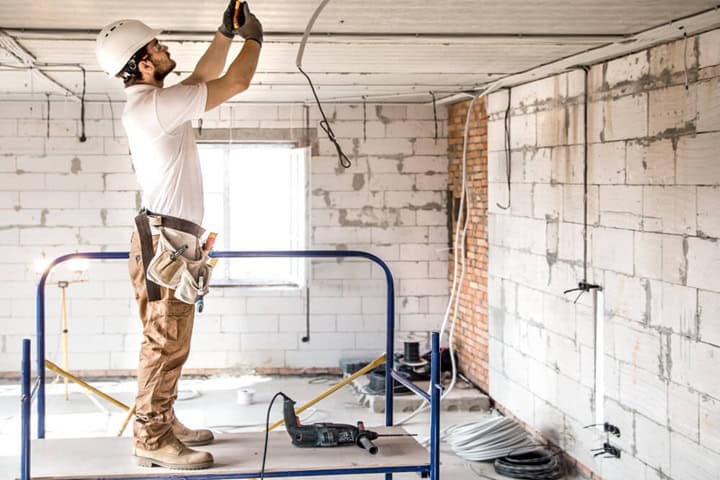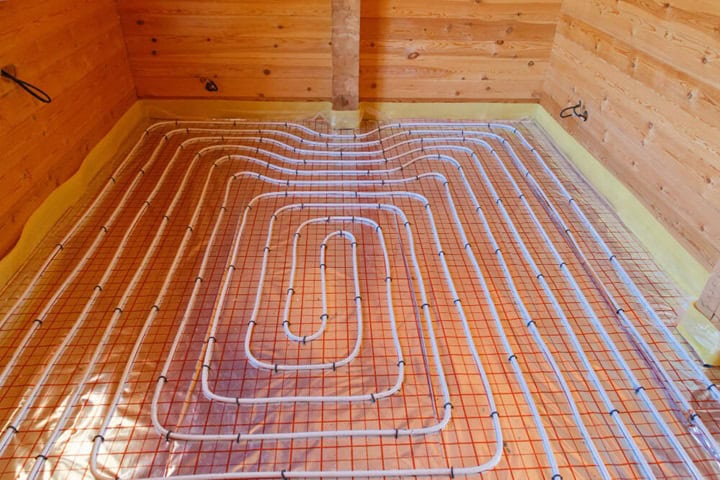Transform your existing property or old home with modern comforts. Retrofitting underfloor heating in old houses combines efficiency with elegance, bringing it into the 21st century in style.
A common query associated with underfloor heating is whether or not these technologically advanced systems can be installed in old houses or existing properties. Fortunately, the answers may surprise you. In this article, you will learn about installing underfloor heating in old houses, what cautions to consider beforehand, which system is best for old, existing properties, and how a difference between retrofitting and refitting can make a big difference!
Key points:
- Understand the difference between retrofitting and refitting underfloor heating systems.
- Discover the most suitable underfloor heating options for older properties.
- Learn the steps for assessing your home’s suitability for underfloor heating.
- Gain insights on minimising installation disruption in occupied homes.
- Explore energy-saving tips to maximise the efficiency of your new heating system.
Can You Retrofit Underfloor Heating For Home Renovations?
Yes, retrofitting underfloor heating in old houses is a suitable option for those looking to increase their home’s warmth and efficiency during a renovation.
By installing a new heating system directly over existing subfloors, homeowners can avoid the extensive modifications associated with new builds. This approach allows the integration of both electric and wet underfloor heating systems into existing homes, offering a modern solution that respects the building’s historical integrity.
Check out these top tips for renovating an old house.
What’s the Difference Between Retrofitting vs. Refitting?

The terms ‘retrofit’ and ‘refit’ are distinct and carry important implications for installing underfloor heating, to such an extent that we have a full article that covers retrofitting underfloor heating.
In simple terms, retrofitting refers to the process of installing a new underfloor heating system into an existing structure without removing the original subfloors. Doing it this way is ideal for those that aren’t looking for an overall renovation of the structure as well.
Conversely, refitting involves removing an existing central heating system to install it in a different location or replace it with a new one. However, this is generally not advisable with underfloor heating systems due to the risk of damaging the integral components like heating wires and mesh mats, which are designed to be installed once and not moved.
Factors to Consider for Retrofitting
When choosing an underfloor heating system to retrofit in an existing home, it’s crucial to consider the impact on floor height.
Unlike in new builds, where adjustments to floor levels are more flexible, existing homes require systems that integrate seamlessly without altering the overall floor structure significantly.
Electric underfloor heating systems are better for retrofitting due to their minimal height adjustments. Systems that incorporate ultra-thin heating wires can be embedded directly within tile adhesive, adding only millimetres to the floor height and preserving the original room proportions.
Wet underfloor heating can be used, too, but be aware that due to the size of the pipes that these may raise the flooring within the home.
Is The Property Structure Suitable For Underfloor Heating?
Before you start installing underfloor heating in an existing house, it’s essential to evaluate several critical aspects to ensure compatibility and effectiveness:
- Floors: Check if your current floors can support the extra weight and structural changes needed for underfloor heating. For wooden or suspended floors, you might need additional support or modifications.
- Insulations: Effective insulation is crucial for underfloor heating systems. Many older homes may not have sufficient insulation, which is necessary to prevent heat from escaping downwards, thus reducing efficiency.
- Flooring Materials: The type of flooring can significantly impact the performance of underfloor heating. Materials like porcelain or ceramic tiles are ideal due to their excellent heat conduction properties. If your home has carpets or certain types of wood, consider replacing them with more suitable materials to maximise heat transfer. Learn about the best flooring for underfloor heating for further details.
- Disruption Tolerance: Installing wet underfloor heating in an existing house can be disruptive. Floors may need to be lifted, and some spaces may become temporarily inaccessible. Assess how much disruption you can accommodate during the installation process.
What About The Subfloor?
Most subfloors are made from suspended timber floors. Prior to adding underfloor heating to the existing property, there are two options:
- Remove the floorboards and install the heating system between the joists, with insulation placed underneath for enhanced efficiency.
- If structural adjustments are a concern, consider a low-profile overlay system that can be installed directly on top of existing floorboards, minimising disruption and height addition.
If, however, the subfloor is made from concrete flooring, this will fortunately be less labour-intensive. You can lay heating elements directly on the slab, covered by a thin screed to ensure a more efficient heat distribution.
For homes lacking the necessary clearance for traditional screed, slimline systems can provide an effective alternative without significantly raising floor levels.
Choosing the Right Flooring
As well as porcelain, ceramic, and concrete flooring, stone flooring also performs well, holding and radiating heat effectively. These floor types will work best in kitchens, bathrooms, and garages.
For those preferring a warmer underfoot experience, timber options are available, too. Engineered wood, constructed from cross-laminated layers topped with a hardwood veneer, is suitable due to its stability and lower heat resistance compared to solid wood. However, care must be taken to accommodate the natural expansion and contraction of the wood with temperature changes. These floor types will work best in living rooms (or lounges), and bedrooms.
If softness is a priority, underfloor heating can also be installed under carpeted floors. It’s important to ensure that the total insulation value (Tog rating) of both the carpet and underlay does not exceed the recommended maximum. This prevents excessive insulation that could hinder the efficient upward flow of heat.
Choosing the Right System
Electric underfloor heating systems are particularly suited for retrofit projects as they typically require minimal adjustments to existing floor structures.
These systems can be installed within the tile adhesive layer, adding minimal height to the floor and offering a straightforward, efficient heating solution.
Benefits of Installing Underfloor Heating in Old Houses

Traditional older homes are known for their high energy consumption, especially during colder months. So what benefits can underfloor heating in old houses bring?
- Producing Heat: Underfloor heating systems distribute heat more evenly than conventional radiators, which tend to create uneven hot and cold spots. This even heat distribution ensures that less energy is required to maintain a comfortable temperature, leading to reduced heating costs and a smaller carbon footprint.
- Energy Conservation: Underfloor heating systems in old properties can dramatically decrease energy wastage, lowering energy bills as well as being environmentally friendly. The reduction in energy usage translates directly into lowered CO2 emissions, making underfloor heating a greener choice for heating older homes.
- Structure Protection: One of the most significant advantages of underfloor heating is its invisible nature. Unlike bulky radiators that can detract from the aesthetic of period features, underfloor heating is completely hidden. This system allows the historical charm of the property to remain undisturbed, offering warmth and comfort without impacting the visual appeal of traditional spaces.
Limitations of Underfloor Heating in Existing Homes
Retrofitting underfloor heating in historical buildings can still have limitations, much like any other structure.
- Structural Limitations: Old houses can present unique challenges such as uneven floors, narrow crawl spaces, or limited vertical space for installation. Solutions like using adhesives and self-levelling compounds or opting for low-profile heating systems can help overcome these issues. These methods ensure that the integrity and character of the original flooring are maintained while providing the necessary upgrades for efficient heating.
- Hiring a Professional: Whilst this isn’t strictly a limitation, it does limit the chances of installing underfloor heating yourself, so hiring a qualified professional is the better option here. Contact us to see how our dedicated team has the expertise to tailor installation strategies that respect the building’s integrity while ensuring the best heating performance.
Top Tips for Fitting Underfloor Heating in Old Houses
- Remove the existing floor finish to avoid damage during reinstallation.
- Thoroughly clean and prepare the subfloor, adding necessary insulation for optimal energy efficiency.
- Choose suitable floor coverings such as carpet, wood, stone, laminate, or vinyl based on aesthetic and functional needs.
- Reinforce subfloors when using heavier materials like stone or tile to prevent flexing.
- Employ a certified electrician to handle the design and installation of electrical underfloor heating systems, ensuring adherence to safety standards.
- Install high-quality insulation to direct heat upwards into the room, improving heat efficiency and reducing warm-up times.
- Integrate smart heating controls to fine-tune temperature settings automatically, further optimising energy usage and comfort.
- Schedule regular maintenance checks to ensure the system operates efficiently and address any issues early.
- Consider subscribing to a maintenance plan for regular service and support, ensuring long-term performance and reliability.
In conclusion, retrofitting underfloor heating in existing homes, particularly old houses, offers significant benefits such as better energy efficiency, environmental friendliness, and the preservation of architectural charm. Success in such projects requires careful planning, choosing the right systems, and professional installation. Following these tips can help you achieve a comfortable, energy-efficient home without compromising its historical value.
Now that you understand how underfloor heating can be added to old houses, what about heat pumps?
FAQs
Can I use my existing boiler for underfloor heating?
Yes, you can usually use your existing boiler for underfloor heating, provided it has enough capacity to handle the additional demand. Most conventional boilers are compatible with both electric and hydronic (water-based) underfloor heating systems. However, it’s important to ensure that the boiler can supply water at the correct temperature needed for underfloor heating, which is typically lower than that required for standard radiators.
Do I need to replace the existing flooring to install underfloor heating?
Not necessarily. Electric systems can often be installed directly under existing flooring materials. However, for hydronic systems, you might need to lift the current floor to install the pipework and insulation.
Will installing underfloor heating damage the historical character of my property?
Careful planning and the use of appropriate materials can minimise any impact. It’s often possible to install underfloor heating without any visible changes to the property’s appearance.
Are there any grants or incentives available for installing underfloor heating in older properties?
Depending on your location, there may be grants or incentives to help offset the installation costs, especially if the upgrade contributes to energy efficiency improvements. It’s worth checking local government or energy supplier schemes.
Sources
Resi. (2021) 5 crucial tips for renovating an old home. [online] Available at: https://resi.co.uk/advice/general/renovating-old-home [accessed 13/09/24]
Ambrose, J., (2024) Can heat pumps be installed in older properties? The Guardian. [online] Available at: https://www.theguardian.com/environment/article/2024/may/31/can-heat-pumps-be-installed-in-older-properties [accessed 13/09/24]
